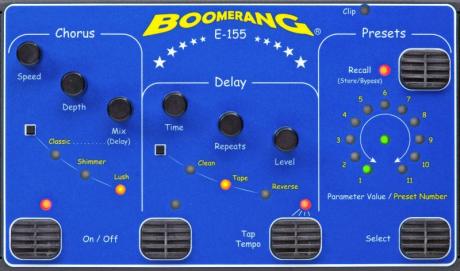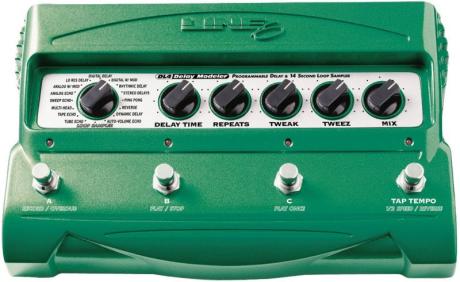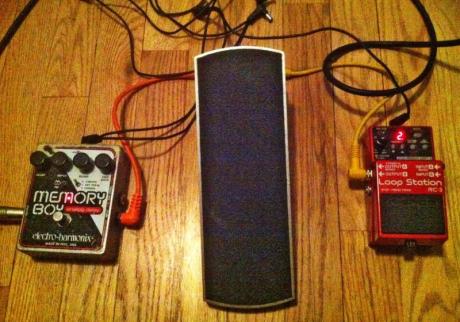Rockové klávesy - Používání looperů při živém vystoupení
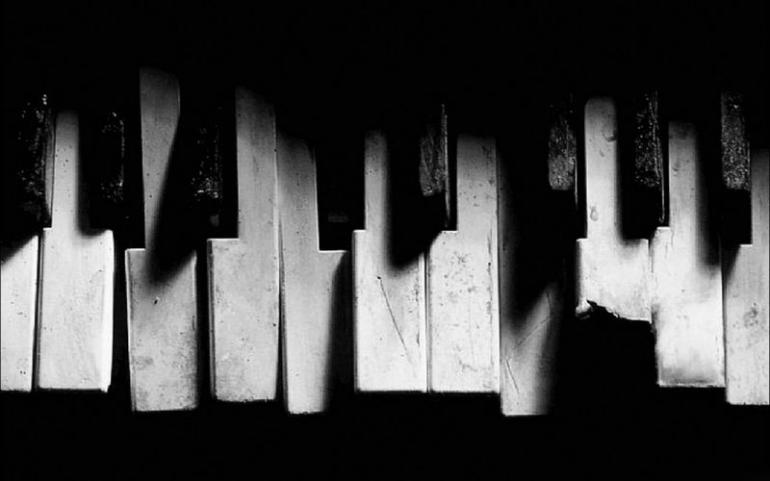
Greetings, readers! I wanted to talk about looping this month as it pertains to live performance situations. As modern keyboardists, I think it’s very important to bring a lot of sonic options to the table. This is why I like to have a few tricks up my sleeve. In my live rig, I always have my Hammond SK-1 for organ and keyboard sounds, a laptop for synth sounds, and lately I’ve been running a Boss RC-3 Loop Station though an analog delay with a volume pedal. My looper is packed with pads organized by key and noise effects also organized by genre and function. These I can bring in and out with volume swells for another color. Let’s examine a few techniques for using loopers for live performance.
Set Up
Check out the enclosed picture. I have my looper going into a Ernie Ball VP JR which then goes into a Electro Harmonix Memory Boy delay pedal. I put this in line after the volume pedal because I like to have a little wash as I bring pads and sound effects in. If I’m using a sound effect that is an unusual sound, I will sometimes activate the vibrato LFO function on the delay. When used in combination with a volume swell you can get really crazy sounds. I then can switch the vibrato off really quickly to go back to the original sound. All these pedals are at the foot of my keyboard rig so my hands are free to play my keyboards up top. You can hook a foot switch up to most looper pedals so you can cycle through the programs without the use of your hands. This is very handy if you have a set list of tunes with your band. You can just put the loops in the order that you will need. I also like to plug my Iphone into the audio input of my looper for yet another sound source. If you read my article last month, I spoke about my two favorite iPhone synth apps; the Morph Wiz and the Animoog. Both are great synths. I leave the first program on my looper free so I can catch cool effects or sounds from the Iphone. I have an iPhone 4 which I love because it's so small and fits very easily behind the EQ knobs of my SK-1. There are many different kinds of loopers, all with slightly different functions. I like the Line 6 delay/looper and the Boomerang very much. The Boss looper I have is cool because it’s very small, and has hundred program slots that I can put loops in. It also has a lot of memory so you never run out of space.

Pads
By far the most common way I’m using my looper in live performance is to cue some pads. If I’m playing a rock or funk gig and the group is playing an f minor 7 jam, I’ll have a few pads programmed in my looper that I can cue for solos. It’s especially cool when I cue pads for my own solos because it sounds like I have an extra hand. Here’s another scenario; let’s say I’m playing a two fisted clav part behind a guitar solo and I want another color. Right before the tune, I dial up the appropriate pad program and actually start the looper with the volume pedal all the way to the off position. As the tune is going on, I will very subtly feather the volume pedal to bring the pad in at points during the guitar solo.
I record my pads into the looper in a few different ways. One method I like is to get a synth sound I like and play sparse single notes with space in between with some delay. I’ll create a thirty second loop on the pedal and then overdub more parts in one key or mode. When the loop is playing it sounds like washy lines are coming in and out. This works great over diatonic chord progressions if the notes you recorded are all in a particular mode. With the use of the volume and delay pedals, you can get just the right vibe. Another pad looping technique is to hold a chord on the synth that’s going into the looper with a chord voicing that you like. After you play the chord, hit start on the looper. Let it loop for a few seconds’ maybe ten then hit stop. If you do this smoothly it will sound like you are just holding the chord and the start and end points of the loop will be hard to detect.
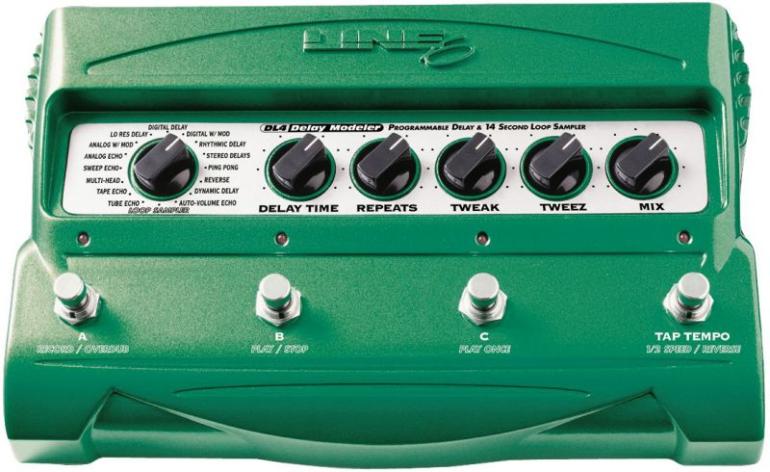
One Shots
Many loopers have a one shot function. This is a short recording that doesn’t repeat and can be quickly sounded again once the recorded section has played. I like to set up some horn stabs or dance hits on my one shot. I again group them according to key to quickly find them in the looper programs. When recording your one shot, try to make sure they start right away. This will make it so you can cue the sound in time when you are playing. I also practice getting the tempo of the song just right so the one shot lines up really well. For people who want to take the tempos really seriously, some loopers have a click that can be sent as an audio out. Some groups go all the way and use Ableton Live with a click and headphones for the band members to really lock the time.
Another good use of the one shot function is for noise or sound effects. Sometimes during a downtempo electronica jam, I’ll have some glitchy keyboard patch cued up on my one shot. I really like circuit bent electronic samples. These are keyboard patches that have been doctored with some kind of glitch effect to create unusual misfires. With a little delay and careful use of the volume pedal you can really get cool soundscapes. We can use the same techniques with vocal samples. Sometimes on a very mantric, hypnotic section I’ll have a sample of some monks singing on my looper that I bring in and out just like the noise samples to add to the mystique. This will also be in the right key so I usually have a few of these grouped in the same way I do the pads. I usually keep a card on the top of my keyboard with the grouped programs for fast reference.
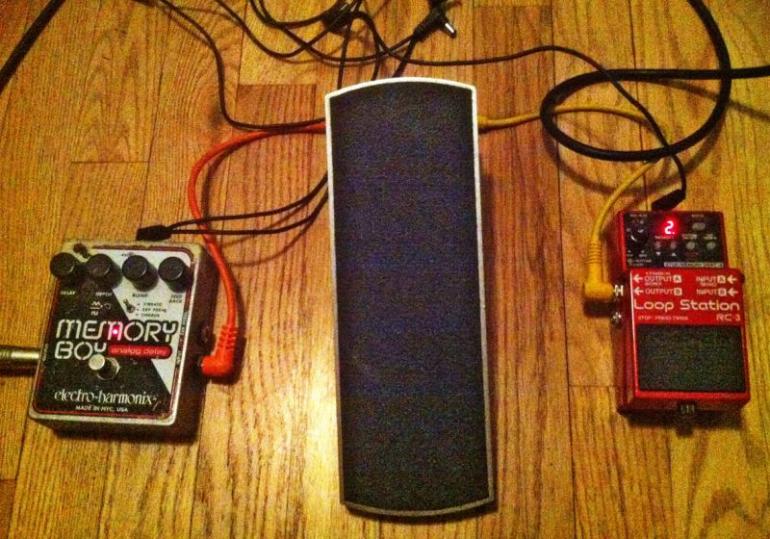
Drum Breaks
This is a cool thing to do when you want to get a different color in the rhythm. It will also free the drummer up to do a counter rhythm if he wants. Sometimes I’ll start a piece with a loop so the drummer gets to hear the tempo then I’ll let him take over. Some people like to use a click for these types of things, but I like to just go for it live. If you have a drummer with good time, it’s actually not that hard to go back and forth from the loop to the live beat with a little practice. You can also have the drummer play with the loop. Experiment with using the vibrato or modulation effect on your delay while the loop is playing. You can do really cool things to the beat. Keep the feedback low so it doesn’t get too mushy.
Fráze a hudební termíny:
Looper: Drtivá většina z vás ví, co to je, ale protože jsou loopery hlavním tématem článku, pojďme si ujasnit pojmy. Looper je zařízení, do kterého můžeme nahrát libovolnou zvukovou sekvenci a ono ji na náš povel bude přehrávat neustále dokola.
Tricks up my sleeve: Trumfy v rukávu, připravené „finty“.
Wash: Mimo hudební svět je jasné, co to znamená. Ale co v hudbě? Většinou tím slovem myslíme (spíše záměrně) slévající se zvuk. Tak jako když bubeník hraje doprovod na činel přes hranu, také někdy používáme výraz „wash“.
LFO: Low frequency oscillator, tedy nízkofrekvenční oscilátor. Zpravidla jej používáme pro tvorbu či upravování (modulaci) nejrůznějších efektů, např. vibrata či tremola.
Volume Swell: Efekt, kdy pomocí potenciometru hlasitosti nebo díky volume pedálu můžeme docílit zvuku, který začíná tiše (nebo „od nuly“) a jeho hlasitost se postupně zvyšuje...
Feather: Ano, znamená to „pírko“, ale zde je výraz použit jako sloveso, tedy „jemně se dotknout“...
Overdub: Sloveso i podstatné jméno, znamenající „nahrát něco k již existující nahrávce“.
Horn stab: Akcent dechové sekce. Zpravidla se jedná o akord hraný staccato a důrazně dechovou sekcí.
Cue: V divadelním světě se jedná o signál (narážku), že má určitý herec přijít na scénu, případně pronést konkrétní výrok apod. V hudbě lze tento pojem použít podobně. Ve článku je tím myšleno „spustit něco ve správný moment“.
Glitchy: Přídavné jméno znamenající trhaný, „škobrtavý“ nebo jinak „nekvalitní“ zvuk (což je však někdy žádoucí).
Misfire: Když je nějaký zvuk či efekt spuštěn neplánovaně, zdánlivě náhodně. Jak ale píše Brian, „misfires“ mohou být někdy i žádoucí.
Feedback: Zpětná vazba, avšak v článku je výraz použitý jako „parametr ovládající počet opakování u efektu delay“.
Mushy: Zvuk, který je nezřetelný, „rozplizlý“.

